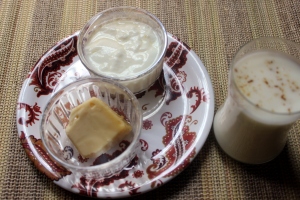Curds and Cheese
Curds and Cheese are two types of dairy products that differ not only on the nutritional value but also in the method of preparation. Curd is made from milk fermentation and the lactic acid produced gives the tangy flavor.
On the other hand, cheese is made from acidification of bacteria and the type of bacteria used gives the unique taste to different types of cheese. Curd has lot of medicinal benefits as it has the live helpful bacteria, which makes it suitable to those who are lactose intolerant. It is also helpful in irritable bowel syndrome and digestion problems. While both yogurt and cottage cheese contain lactose, the live cultures in curd turn lactose into lactic acid in the gut, making the dairy sugar easier to digest.
- Curd is prescribed in the treatment of inflammatory bowel syndrome, colon cancer and diarrhoea. Curd and cheese also differ in their nutritional profile.
- Curd is obviously the winner if it is concerning calorie levels. It is much lesser in calories than any type of cheese. However curds available in the market are mostly prepared from buffalo milk, which is high in fat. Curds from cow’s milk are healthier with lower calories and high nutritional level. So, the best thing for us to do is to prepare curds at home by removing the cream layer from milk or buy good quality slim milk and ferment it to prepare healthy curds.
- So what happens if there is cream in curds? The cream in curd when consumed gets stuck in small projections called villae in the small intestine. the main function of small intesting is to absorb the essential nutrients of all foods passing through it. When these minute projections called villae gets clogged over a period of time, it starts interefering in the functioning of small intestine. Gradually this results in the increase of the triglyceride content in the blood. It doesn't matter whether you whick the creamy curd/yoghurt to buttermilk. It also adds to the fat content.
• Cheese is higher in protein than curds, but a very interesting fact is that hung curd, which is a concentrated form of yogurt, has a higher level of protein than ordinary curds.
• Both curds and cheese are rich in calcium and minerals like iron, magnesium, potassium and vitamins are one or less the same for both. Sodium content in cheese is very high almost triple quantity than curd. High cheese intake causes a disturbance in the filtration property of kidney and affects the normal balance of sodium-potassium levels in the body.
• According to Ayurveda, curd is hot in potency. So it is advised that it should be avoided in summers. Buttermilk is prepared by whisking curds with water and is cooling in property. Adding spices like hing, cumin powder further helps in digestion.
Why curd and buttermilk are different? The property of curd on whisking is completely changed and thus buttermilk/chaas is very beneficial in summer except for those suffering from cold. By whisking little curd and lots of water, buttermilk is easy to digest and is highly recommended to have along with meals. Buttermilk is alkaline in nature too, so it is a complete balance drink after a large dose of acidic food
- On the other hand, cheese is considered to be tamasic in nature by Ayurveda as it results in constipation, mucus in lungs and is harder to digest than curds. Exception is paneer . Paneer is high in protein and is a must for vegetarians.More info on paneer will be posted soon. Do remember , the key to good health is "everything in moderation".
So make a balanced choice based on nutrition needs in your day to day menu.
